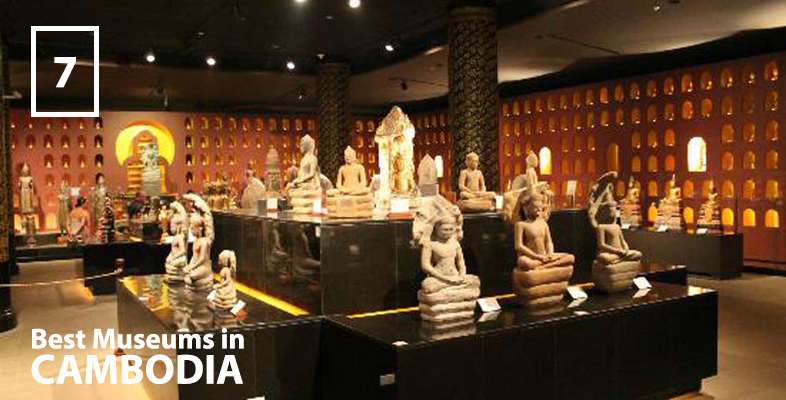
- On 13 August, 2020
- In ALL BLOGS CAMBODIA BLOGS
- Tags Tags: Angkor National Museum, Angkor Panorama Museum, Angkor Wat, cambodia, Cambodia Landmine Museum, Cambodia National Museum, Kampot Provincial Museum, Tuol Sleng Genocide Museum, War Museum Cambodia
TOP 7 BEST MUSEUMS IN CAMBODIA
Cambodia is culturally and traditional rich mainly because of a large number of religious are constructed under the influence of both Buddhism and Jainism but mostly the former. There are a lot of museums in Cambodia but we have handpicked Top 7 Cambodia Museums for you to visit when in Cambodia.
- Tuol Sleng Genocide Museum, Phnom Penh
- Cambodian Landmine Museum, Siem Reap
- National Museum of Cambodia, Phnom Penh
- Kampot Provincial Museum, Kampot
- War Museum Cambodia, Siem Reap
- Angkor National Museum, Siem Reap
- Angkor Panorama Museum, Siem Reap
Tuol Sleng Genocide Museum, Phnom Penh

Address: St.113, Boeung Keng Kang, Phnom Penh.
Phone: 023 6 555 395/077 252 121
Opening hours: 08:00a.m. – 05:00p.m. (Daily)
Admission Fee: US $5.00/Ticket.
It used to be a school but was later turned into a prison. Tuol Sleng Genocide Museum clearly portrays Cambodia’s devastating past. You can walk around and look at all the pictures or you can get an audio tour, but beware, the podcasts are not for the faint-hearted! Stories of torture and mass genocide, as well as artwork, are displayed on the walls.
In this Cambodia museum in Phnom Penh, you get to see the torture rooms, walls stained with the blood of the prisoners and the cells where they were kept.
Cambodian Landmine Museum, Siem Reap
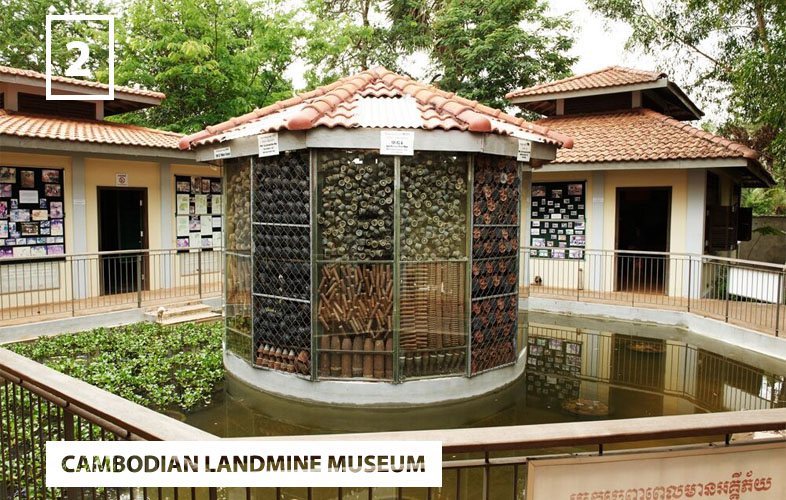
Address: 67 Angkor National Park, Siem Reap.
Phone: +855 (0) 15 674 163
Opening hours: 07:30a.m. – 05:30p.m. (Daily)
Admission Fee: US $5.00/Ticket.
The Cambodian Landmine Museum was established in 1997 by ex-child soldier Aki Ra. After years of fighting he returned to the villages in which he planted thousands of mines and began removing them, by hand, and defusing them with homemade tools.
In 2008 he established a formal demining NGO, Cambodian Self Help Demining (CSHD). CSHD is a separate NGO and apart from the Museum. They clear landmines throughout the country.
The idea for a Relief Facility came around when Aki Ra saw many children wounded by landmines and those in extreme poverty. He brought them to his home, where he and his wife raised them as their own, alongside their own children. Originally, all of the children at the facility were landmine victims. Today the facility cares for children who suffer from a variety of difficulties.
The Relief Facility houses over 2 dozen children from small villages in Cambodia. The children are enrolled in public government school to continue their education. The Facility also has its own school building to enrich the children’s education with a computer lab, a library, English language classes, a playground, and a staff of 14. The Relief Facility accepts volunteers to help teach English, work in the Museum and assist in the office. Please see the Volunteer page to learn how to become a volunteer.
National Museum of Cambodia, Phnom Penh
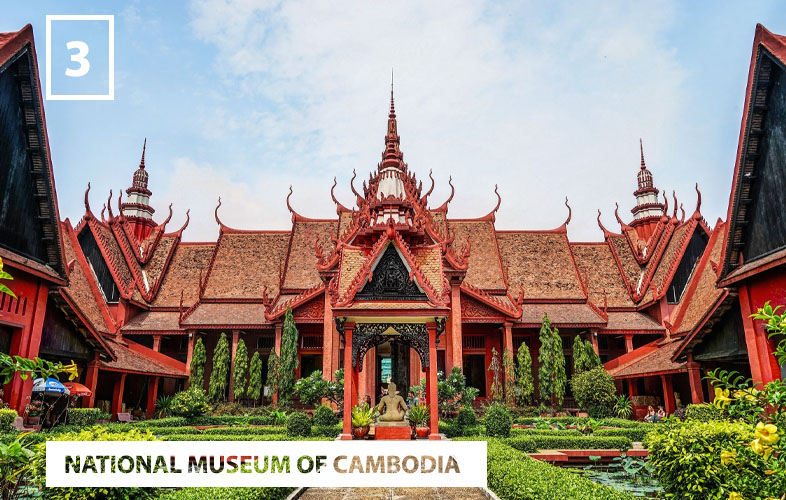
Address: 227 Kbal Thnal, Preah Norodom Boulevard, Phnom Penh.
Phone: +855 (0)23 217 643 / +855 (0)23 217 645
Opening hours: 08:00a.m. – 05:00p.m.
Admission Fee: US $5.00/Ticket.
The National Museum of Cambodia is home to the world’s finest collection of Khmer sculpture: a millennium’s worth and more of masterful Khmer design. It’s housed in a graceful terracotta structure of traditional design (built from 1917 to 1920) with an inviting courtyard garden, just north of the Royal Palace.
The museum also contains displays of pottery and bronzes dating from the pre-Angkorian periods of Funan and Chenla (4th to 9th centuries), the Indravarman period (9th and 10th centuries) and the classical Angkorian period (10th to 14th centuries), as well as more recent works, such as a beautiful wooden royal barge.
Photography is not permitted within the museum galleries, but visitors are welcome to film or photograph the museum exterior and courtyard. Those wishing to obtain images of the museum or collection for study or Publications should email the museum to request an application form or contact a staff member.
Kampot Provincial Museum, Kampot

Address: 735 Kampong Bay, Sala Khet Street, Kampot.
Phone: +855 12 691 832
Opening hours: 08:00a.m. – 11:00a.m. & 02:00p.m. – 05:00p.m. (Daily)
Admission Fee: US $2.00/Ticket.
Aware of the challenge the authorities decided to award to the Museum the historic and prestigious building of the Governorate of Kampot. This building, with the financial assistance of the AIMF, was completely renovated. The interior of the ground floor has been converted to house the Museum, modest, but consistent with the requirements of the modern museum.
The Kampot region has a two thousand year history, its population is diverse and its resources are varied. Kampot city holds an exceptional architectural heritage dating mainly from colonial times. Yet this heritage is largely ignored both by Cambodians and foreigners. The Museum is dedicated to restore their memory to Cambodians and to allow foreigners to learn more about the region . Kampot capital of the eponymous southern province has a charm to which foreigners are sensitive as evidenced by the growing number of foreign residents and the influx of tourists of all nationalities. The city is located between two major attractions that are Kep resort and Bokor hill station. The Museum aims to fill this gap and offer both to residents and to foreigners a cultural site.
The museum currently includes three elements: – A series of 6 large panels depicting the milestones in the history of the province of Kampot. Preferred periods, due to the existence of sources, are pre-Angkorian period, from eighteenth and nineteenth centuries, the colonial period under the protectorat regime and the contemporary period. – The presentation of 38 photos about the history of Kampot. – A dozen archaeological pieces found in the Kampot region. Most of the pre-Angkorian period. Archaeological items made available by the Regional Directorate of Fine Arts.
War Museum Cambodia, Siem Reap

Address: Kaksekam Village, Sra Nge Commune, Siem Reap.
Phone: +855 (0) 97 457 8666
Opening hours: 08:00a.m. – 05:30p.m. (Daily)
Admission Fee: US $5.00/Ticket.
The War Museum in Siem Reap is the biggest War Museum in Cambodia. It offers visitors a unique and insightful view of the perils that Cambodia faced during the last 3 decades of the 20th century. It gives also visitors an excellent opportunity to learn more about what actually occured during Cambodia’s ‘war years’.
It has a unique collection, you will also be able to see war machines like the tank T-54, the jet fighter aircraft MiG-19, the helicopter Mil Mi-8 and the field artillery gun 85-mm divisional gun D-44. Before used in Cambodia, some of these war machines have even seen action during World War II. Among the collection there are also many sorts of landmines and rare photographs from the defined period of time in Cambodia.
You can take a free guide to lead you around. Each of the guides has his own unique background: war veterans, eye witnesses of the war and landmine victims. Therefore, not only they could tell you about the last 3 decades of the 20th century history of Cambodia and about the collection of the museum, but also about their personal experiences during the defined period of time.
Angkor National Museum, Siem Reap
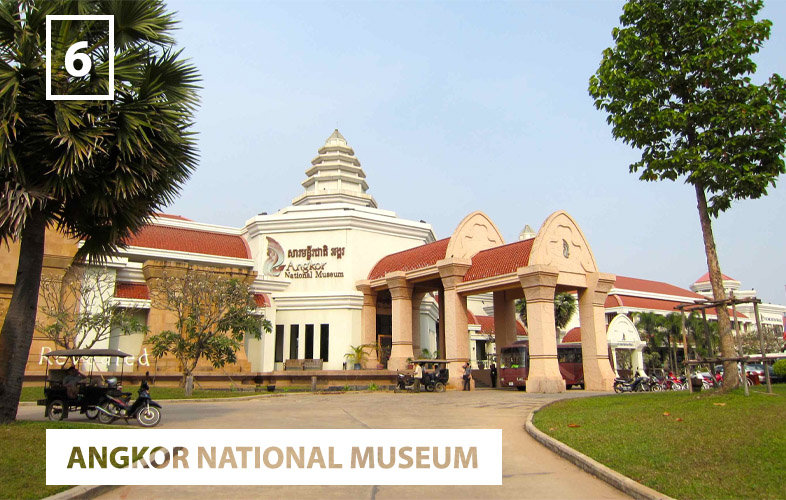
Address: 968 Khom Svaydangum, Siem Reap.
Phone: +855 (0)63 966 601
Opening hours: 08:30a.m. – 06:30p.m. (Daily)
Admission Fee: US $12.00/Ticket.
During the Golden Era of the Khmer Kingdom, one of the ancient civilizations of this world was being created. It was the origin of Khmer art, culture, and architecture. These great inventions became one of the few wonders of the world that still amaze people throughout generations that still hold a great impact in present Cambodia society.
Angkor National Museum takes pride in revealing the royal historical path of this Golden Era of the Khmer Kingdom through state of the art multimedia technology to provide visitors a full pictorial story of the legend for easy comprehension.
Upon your visit From the first step inside the Angkor National Museum, we hope you will be pleased with all the services and facilities we have to accommodate your visit. Providing you with a clear guide map that will allow you to wander through all galleries for an extraordinary experience. In helping you to have a deep and clear understanding of each artifact, Angkor National Museum is glad to assist you with personal translation device or Audio tour set (Available in Khmer, English, German, Korean, Japanese, French, Chinese, and Thai) For your convenience, your personal belongings will be kept in the provided deposit box, free of charge.
Angkor National Museum will take its visitors through the journey back in time from the creation to the highest point of Khmer civilization. Through the use of interactive exhibits, visitors will develop a deeper understanding of customs, traditions and different beliefs of the ancient empire. A tour of the museum will be joyful for both visitors who have a good understanding of ancient Khmer civilization and visitors who do not have any previous knowledge of the ancient Khmer empire. All artifacts are divided into 8 galleries in the order of the evolution which are enhanced by a realistic atmosphere. Throughout the whole experience Angkor National Museum will allow this legend to slowly reveal before your eyes.
Angkor Panorama Museum, Siem Reap
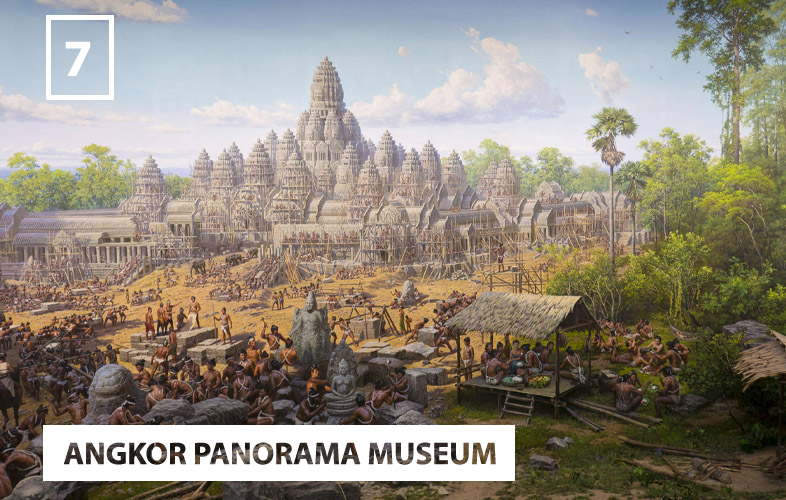
Address: 968 Khom Sveydangum, Siem Reap
Phone: +(855)63 776 215
Opening hours: 09:00a.m. – 08:00p.m.
Admission Fee: US $20.00/Ticket.
The Angkor Panorama Museum provides comprehensive information about the glorious Khmer civilization during the Angkor era and an overview of the temple history, the building and the current layout.
The Museum is Socialist Realist art transported back to a time when Khmer warriors battled with their neighbors using spears, swords and huge fighting elephants. A time when the Khmer empire built stunning temples, which are today, UNESCO World Heritage sites.
The mural took 63 painters from the most famous school of political artistry in North Korea and two years to complete. The result is so captivating that visitors on a recent excursion to the museum expressed doubts as to whether it was the work of mere mortals, brushes and paint, wondering if there could be some sneaky video projection involved.